Genre: Shmup Developer: Soft Vision Publisher: Soft Vision Players: 1 Released: 1993
$150 is what I paid for Eliminate Down (complete in all its glory). That’s right, $150 I could have spent on stuff that I actually need! Instead, I shelled it out for just one game. After playing the game my verdict was simple: Eliminate Down is THE 16-bit shooter! There’s no other way for me to explain how good Eliminate Down is. It’s amazing to look at; it’s amazing to listen to, and it’s amazing to play. It’s also amazing to know that Eliminate Down was developed by an unknown company called Aprinet (this was its only game), while Soft Vision published it (another unknown company). There’s a reason why people are forking out big bucks (for up to $300 on auction sites) for Eliminate Down: it’s excellent! How good is Eliminate Down? Well, if there was a list of the top five best Genesis/Mega Drive shmups, this game would be on that list. It’s very close to pure perfection, but two flaws kept it from a perfect score.
Eliminate Down has very simple controls which won’t confuse you at all. A and C are for your secondary weapon switch while B is your firing button. Your ship has a primary firing shot and three simple secondary weapons. By pressing A or C you can switch your three secondary weapons in the following order: forward (fires forward, causes the most damage), bombs (damage to ground enemies), and back (shoots from the back of your ship). With the different weapons switch your primary firing shot will always shoot forward.
Different but simple power ups can be collected in the game in order to make your ship more powerful. “P” is to increase the secondary weapon’s fire power. If you look at the lower right screen when playing, you’ll see five “Ps” and what level you’re in. Collect five “Ps,” and the secondary weapon level will increase (the maximum level is three, and the default is one). If you lose a ship while your weapons are level two or three, their level will decrease. “E” will upgrade the primary firing shot. Collect three “Es” in order to have your primary shot be a long laser which causes a lot of damage (but a warning: if you lose a ship the primary shot will go back to its weakest form). Pick up B for the shield (it can take up to three hits). Shields don’t come often so you need, so do your best to not lose your shields.
By pausing the game, you can adjust your ship’s speed. While this is a good idea, since you can have 100% control over your ship, it’s annoying to pause the game in order to change the speed. Aprinet could have easily added in a speed change button (like the Thunder Force series); but instead, it thought that it’s much better to pause the game in order to change the ship’s speed. It’s an annoyance at best, but most players won’t even need to change the speed at all.
Controlling the ship is simple, but how does it play? Well once again its THE 16-bit shooter, right? Eliminate Down is a shmup fan’s wet dream. It’s a challenge for the hardcore fan. A good number of 16-bit shmups were a little on the easy side but Eliminate Down is flat out hard to the point of you having to practice every day in order to get the level down in your head. The game isn’t a checkpoint shooter, but it’s hard to the bone (but certainly beatable). One of the brightest points when it comes to gameplay was the level design. Aprinet was most likely made up of shmup fans because it took some ideas from different shmups for good effect. The best example took place in stage five when there were no borders on the screen, and you can go up (or down) forever. Also, the robotic snakes from the ground were very similar to the movement of the fire dragons in the first stage of Konami’s Gradius II. The level designs made the game fun and different to other shmups of the era, and it wasn’t just the old move forward and shoot formula. Eliminate Down forces to you play in different situations and try to survive. Part of stage one forces you to shoot and dodge missiles while your ship is descending to a planet. Another example is in stage five when one moment you’re in the Gradius-inspired area, and the next moment your ship is moving down and getting bombarded by the enemy on both sides.
The reason Eliminate Down’s level designs change so quickly is because each stage is split into two parts. What separates the parts are the mini-bosses, which are fun and creative for the most part. While stage one’s mini-boss is too easy, state two’s and up are actually a challenge and fun to fight against. Of course, the mini-boss is not as hard as the end boss of the stage. Real boss battles are once again creative and hard as they should be. They’re not just simple small sprites; they mostly cover the whole screen (the stage two boss is actually a whole battleship which pays homage to Irem’s R-Type)! Each boss is totally different in attack pattern so the key to defeating them is to study their movements.
The graphics, for the most part, were great. Except for some stages which the backgrounds animate, the backgrounds are mostly static, but the stages where the background animates look great. Stage one is the best example of how good the background animation can be. So where did most of the animation go? The sprites. Sprite animations is smooth and detailed, putting many 16-bit shmups into shame. Most, if not all mini-bosses and end bosses are animated nicely, and Aprinet didn’t waste any ROM space for animations because some of the best sprite animations in 16-bit can be found here. The same can be said about the color issue that plagues most Genesis/Mega Drive games. Aprinet did a good job with color because the game is detailed nicely. It’s true that Lightening Force/Thunder Force IV is better in the graphics department (and it came out a year earlier) but Eliminate Down can still hold its own ground. When you beat the stage, you’re treated to a yellow explosion and then a stage clear, pretty good graphical effect from Aprinet (the explosion is homage to Taito’s Metal Black).
If there was one thing to complain about in the graphics department, it would be the sprite flickering/break up. Eliminate Down is a crazy shmup that can be hectic at times (well, maybe a little too hectic). If you upgrade your primary shot to its final form (the laser), it’ll cause flickering in a lot of spites when hitting the enemy. While flickering is not bad, depending on the game, in Eliminate Down’s case flickering also affects the bullets. In other words, from time to time it makes the bullets hard or almost impossible to see. The flickering is not as bad as the Grind Stormer port done by Tengen, but it can be a problem later in the game (but not in a way to make the game unplayable). The sprite flickering was the only real complaint I had against Eliminate Down, but once you play it you’ll forget about flickering altogether.
A good shmup also comes with good music, right? Eliminate Down has some great music tunes which fits the action or the level’s theme perfectly. It may be true that Lightening Force/Thunder Force IV has better music, but once again Eliminate Down can hold its ground. The mini-boss’s tune is arguably the best one in the game because it’s a perfect example of how to use the Z80 chip correctly. The other tunes are either great or OK at best, and the sound effects are pretty good, with some wonderful sounding explosions and moving robotic parts which actually sound pretty real.
If you go in the options menu there’s a special mini-game for you to play. It’s a simple “hit the card when it flips” affair. Move the aiming icon around and try to hit a card that’s in the middle of flipping. You only have sixty seconds to play the game, but it gets harder when the timer starts to run out. It was nice of Aprinet to program the mini-game, because it’s a cool extra.
Well, there you have it. Except for the sprite flicking (and the speed change mishap) Eliminate Down delivers. You want a real 16-bit shmup on any system; Well, this one fits the bill. In some respects, Lightening Force/Thunder Force IV is better, but Eliminate Down can still compete more than competently. The challenging level design is some of the best I’ve ever played in a 16-bit shmup. It’s unique, and it pays homage to other great shmups of the past. To truly understand why I think Eliminate Down is the second-best Genesis/Mega Drive shmup behind Lightening Force/Thunder Force IV, just play it on the emulator!
The hardest part of doing the review of Eliminate Down was the score. The game to me is higher than an eight, but lower than a nine. Personally, I would be happy if I gave the game an 8.5 (for sprite flicking, which I took a point off for, along with the speed change mishap, which should be a half point off). Since we don’t do half-scores over here at Sega-16 I must give it an eight or a nine. After thinking about it (and rounding up) I’ll give Eliminate Down a nine. It’s close to perfection, and the good overrides the bad 10x over.
P.S.: If you’re serious in importing Eliminate Down, prepare to pay $150-$300 for a complete JP copy since it’s one of the highest demanding Mega Drive shmups on the system. Most people didn’t know that there was also a Korean release as well (published by Samsung). It still goes for a pretty penny, but it should cost less than a JP copy. Both the Korean and JP copies use the same cover art (except the Korean version, where there’s a white border around the cover art).
SCORE: 9 out of 10

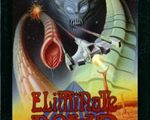
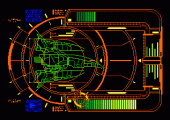
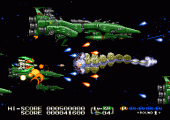
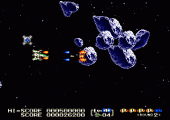
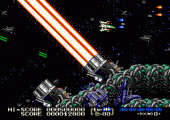
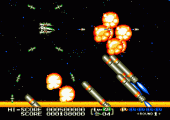
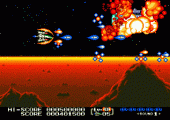
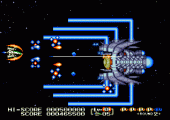
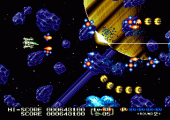
This shameless glorification of the game is actually completely spot on! I recently finished the game and all I can say is WOW! 10/10 from me